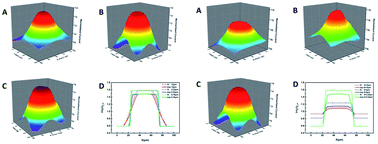Theoretical and experimental verification of imaging resolution factors in scanning electrochemical microscopy†
Abstract
The imaging resolution of scanning electrochemical microscopy (SECM) depends strongly on the tip electrode size and the tip–substrate distance. Herein, etched glass encapsulation was applied to fabricate a gold disk electrode, and the size of the tip electrode was accurately determined from the steady-state limiting current. Referring to the theoretical research carried out by our predecessors, the formula for the imaging resolution was derived, followed by the imaging of gold spots and cells with the prepared microelectrodes of different sizes and with different tip–substrate distances. A depth scan was performed to generate 2D current maps of the gold spot relative to the position of the microelectrode in the x–z plane. Probe approach curves and horizontal sweeps were obtained from one depth scan image by simply extracting vertical and horizontal cross-sectional lines, and further characterized by comparison with simulated curves through modeling of the experimental system. The experimental results were basically consistent with the theory, revealing that the highest imaging resolution can be obtained with the smallest tip electrode when d/a = 1, and when the size of the tip electrode is fixed the smallest tip–substrate distance can give the highest imaging resolution.

- This article is part of the themed collection: Analytical Methods HOT Articles 2021


 Please wait while we load your content...
Please wait while we load your content...